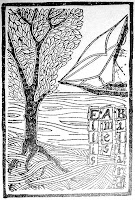 Despite all the new movie characters you will see portrayed by children in costume come Halloween, you might still spot that perennial favorite Frankenstein. Usually that depiction will be modeled on Boris Karloff's makeup in the 1931 movie (perhaps all the way down to the lug-bolts on each side of the monster's head, an indication that he was put together from parts). That movie has also been the primary vehicle through which people have learned a Frankenstein story. But that movie diverged in significant ways from the original British novel by Mary Shelley. And what was left out may tell us something significant about life, and even other species.
Despite all the new movie characters you will see portrayed by children in costume come Halloween, you might still spot that perennial favorite Frankenstein. Usually that depiction will be modeled on Boris Karloff's makeup in the 1931 movie (perhaps all the way down to the lug-bolts on each side of the monster's head, an indication that he was put together from parts). That movie has also been the primary vehicle through which people have learned a Frankenstein story. But that movie diverged in significant ways from the original British novel by Mary Shelley. And what was left out may tell us something significant about life, and even other species. |
| Mary Shelley |
So far, novel and movie are roughly the same. The critical question is: How will complications appear? What matters has the scientist overlooked that will lead to difficulties (something any good plot needs, horror story or otherwise)? In the movie, an explanation for the damage that will ensue is provided by the scientist's assistant unwisely having substituted a criminal's brain for a normal person's brain. But Mary's book provided no such easy out.
In the movie, the monster was mute and slow-witted (probably because of that inadequate brain). In quite a contrast, the book's newly created living being is precocious, and quickly learns to talk quite well. He even learns to read, and becomes quite erudite. How could anything go wrong?
And yet, there are problems from the start, and they have to do as much with the scientist as with the monster. The new being, desiring contact, reaches his hand out to the scientist's, but the scientist pulls back, avoiding touch. That will be the key to the problems that continue to develop as the new being seeks companionship but cannot get it, and also seeks a mate but cannot find one. For, after all, this new being is the only one of its kind. Like all living beings on this planet, he needs others of the same species. It is as if he were the last of a virtually extinct species the moment he was "born."
To put it in a nutshell, to me, Mary Shelley's monster story suggests not just the danger of arrogant science, but the even greater problems of living and of loving. If social species such as mammals and birds could watch movies, they might also identify with the "monster."
~~~
Have you ever identified with a monster in a movie, or thought about why we sometimes can?
(The drawing of Frankenstein is by André Koehne
and is used under a Creative Commons Attribution-Share Alike 3.0 Unported license.)
(The portrait of Shelley is in the Public Domain because its copyright has expired.)

